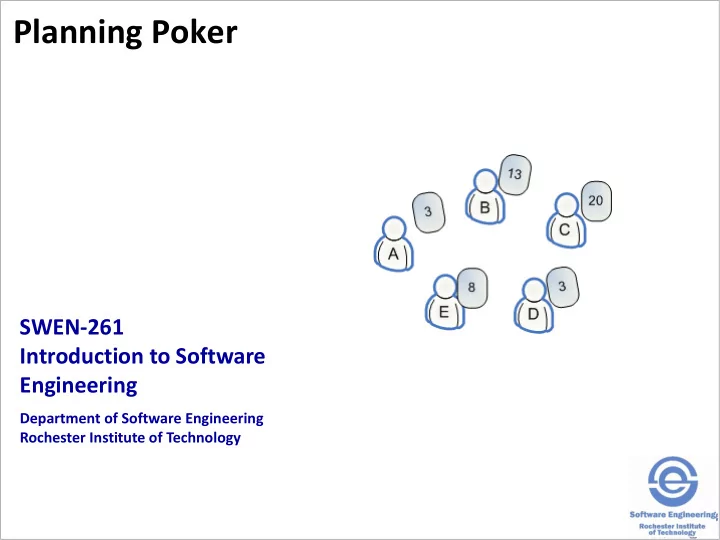

Planning Poker SWEN-261 Introduction to Software Engineering Department of Software Engineering Rochester Institute of Technology
Planning poker is an estimation technique that provides detail during the Sprint Planning activity. Product Sprint Backlog Sprint Backlog Backlog Refinement Planning 1. Analyze story 1. Review the next story on the backlog 2. Design solution 2. Estimate using Planning Poker 3. Does story fit in sprint? • Yes : add to Sprint Backlog • No : keep on Product Backlog 4. Is Sprint full? • Yes : Done! • No : go to step 1 and repeat. 2
Planning poker is a technique devised by Mike Cohn. It is a form of expert estimation in which every team member is an expert. The points assigned are abstract; they do not relate to hours of effort. • A sprint's capacity is not in hours but "level of effort" The point system provides relative levels of effort. • Small effort: 0, ½, 1, 2 or 3 • Medium effort: 5, 8 or 13 • Large effort: 20, 40 or 100 • Unknown: ? 3
There are other forms of software estimation. Expert estimation • Work-breakdown (bottom-up) estimation • Wideband delphi • Planning poker (variation on Wideband delphi) Formal estimation model • Analogy-based estimation • Parametric models • Size-based estimation models Combination • Mechanical combination • Judgmental combination 4
Here's how Planning poker works. 1. The Product Owner reads the top story on the Product Backlog. 2. The team reviews the acceptance criteria and the suggested solution design. 3. To vote, each player picks the point card for his or her estimate. 4. Players reveal their cards all at once. 5. If there is consensus on one number, you're done. 6. Otherwise: 1. Have the outliers (high/low) explain their position 2. Team discusses 3. Vote again until consensus is reached 5
What should the team do if no consensus is found? There are usually two issues that prevent consensus. Product uncertainty: • The requirements (acceptance criteria) are too vague • Send the story back for further (analysis) refinement Technical uncertainty: • Identify the uncertainty in the solution design • Create a spike story for this sprint to establish certainty • Send the story back for further (design) refinement In either situation, the story should stay on the Product Backlog until the uncertainty is resolved. 6
Recommend
More recommend